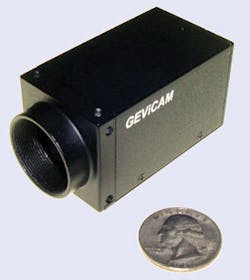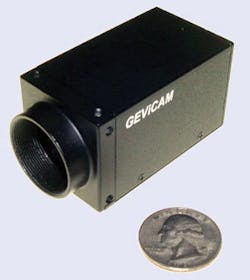GigE cameras to embed neural-net processor
Andrew Wilson, Editor, [email protected]
Ten year’s ago Guy Paillet, partner in General Vision (Petaluma, CA, USA; www.general-vision.com) and Toshi Hori, then president of Pulnix (San Jose, CA, USA), formed an alliance to develop a neural-network-based camera. The resulting product, known as ZiCAM, was based around a hardware neuron chip called a zero instruction set computer (ZISC) whose concept, invented by Paillet, was jointly developed with an IBM team led by Pascal Tannhof in Paris (see Vision Systems Design, October 1998, p. 50). After purchasing Pulnix in 2004, JAI (Glostrup, Denmark; www.jai.com) decided to discontinue further support of neural-network-based cameras, instead opting for more-traditional methods of camera design.
For its part, however, General Vision did not abandon the idea and today offers a number of different trainable vision-system configurations based around the technology. One system, the CogniSight4-Iris, is a neural-network implementation based around the Iris smart camera from Matrox (Dorval, QC, Canada; www.matrox/imaging). Running General Vision’s CogniSight image-recognition library, more than 30 trainable vision systems have been deployed by Pisces VMK (Wells, MI, USA; www.pisces-ind.com) to automate the inspection of fish (see Vision Systems Design, September 2006, p. 29). Most of these systems are based on ZiCAM and have been in continuous operation for more than three years; some others are based on the Iris powered by the CogniSight software neurons simulation.
To speed this classification process, however, requires a faster hardware implementation. While the original ZISC processor used in the Pulnix camera used just 78 neurons/chip, both Paillet and Hori recognized the need to incorporate a more powerful version of the device into a camera system. To do so, Hori has formed GEViCAM (Sunnyvale, CA, USA; www.gevicam.com), a company that will exploit the power of a higher-performance hardware neural network device named CogniMem in a range of GigE-based cameras.
“Initially,” says Hori, “these cameras will not incorporate the CogniMem device. Rather, they will be offered as a series of modular cameras that support CCD devices from Kodak Image Sensor Solutions (Rochester, NY, USA; www.kodak.com) and Sony Semiconductor (San Jose, CA, USA; products.sel.sony.com/semi/ccd.html). These will include VGA, XGA, SXVGA single-tap version, and 1k × 1k and 5-Mpixel dual-tap devices. Like the approach of many other camera vendors, GEViCAM’s modular approach will consist of a series of small-form-factor boards that perform image capture, ADC, power, and a GigE interface all linked by a proprietary connector.
“Rather than simply purchase GigE interface boards from Pleora Technologies (Kanata, ON, Canada; www.pleora.com),” says Hori, “GEViCAM has worked with Pleora to embed both its GigE core and camera timing in the camera’s FPGA. The company’s camera, which was displayed at Photonics West (San Jose, CA, USA; January 2007), is a color SXVGA camera that measures just 34 × 34 × 60 mm and features trigger input, strobe output, optoisolated I/Os, and an RS-485 or CAN interface (see photo).
One of the smallest GigE cameras on the market, the GEViCAM VGA-based camera measures 34 × 34 × 60 mm. Future versions will incorporate a neural-network-based image processor in the package.
To offer a CogniMem-based version of the camera, Hori will once again team with General Vision. “Although the original ZISC processor featured just 78 neurons/chip,” says Hori, General Vision has recently joined forces with Recognetics (Suzhou, China; www.recognetics.com) and retained Oki Semiconductor (Tokyo, Japan; www.okisemi.com) with Hori’s assistance to develop a chip with 1024 neurons, which also includes the feature-extraction logic, making it the first trainable image-recognition chip. This device will be supported by General Vision’s Image Knowledge Builder software training and validation tools and will be available in late 2007.
To allow system developers to deploy this neural-network-based software in machine-vision and image-processing applications, GEViCAM will incorporate the device into its range of GigE-based cameras. “By doing so,” says Hori, “we expect that neural-network-based image recognition will become more prevalent in machine-vision systems and that the principle will move a step forward toward real human-like intelligence.”

